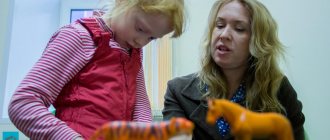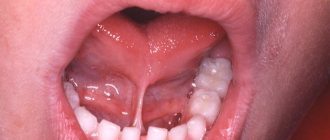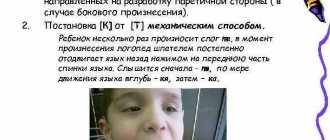Speech development of children 2-3 years old
In the speech of a child of the third year of life, the sounds [s'], [l'], [th'], as well as [g], [x], [k], [m], [p], [b] should appear. , [n], [v], [f], [d], [t], and, of course, all vowels.
Although the pronunciation of many sounds is still very far from ideal, this is due to the mobility of the muscles of the tongue and lips, which are not yet sufficiently developed. The child replaces most difficult sounds with easier ones to pronounce. So, the baby replaces hissing sounds with whistling sounds: “tsai” (tea), “zyuk” (beetle). A child’s vocabulary expands quickly, reaching approximately 300 words by the age of two, and up to 1000 words by the age of three. By the third year of life, the baby enjoys listening to simple fairy tales and stories, and easily carries out simple verbal instructions. By the age of 2.5 years, the baby should already have developed phrasal speech; phrases often consist of two words “mama give”, “mama pi”. But do not sound the alarm if your child does not start speaking at two years old, this is all very individual and often children begin phrasal speech by the age of three. The age of two or three years is considered the most critical and it would not be out of place to see a specialist in the absence of phrasal speech.
Can sounds stand up on their own?
About the sounds of early ontogenesis, we read the post “Speech (for information)” - these sounds, as a rule, really arise on their own.
“What interferes with the development of speech” (about the delayed start of speech in children) A small digression: in the last five to seven years I have observed a more frequent absence than before in the speech of children over 3 years old of the sounds T/D or K/G, more precisely, replacing one pair of sounds with another: “Goose = Dus, House = Gom, duck = uKka” or vice versa, “Cat = Tot, Slippers = Kapki, uTKa = uTTa.” Despite the fact that we pronounce the soft derivatives of these sounds (t/d; k/g) clearly, for example: “DeTi, Kisa.” In general, softening all consonants at an early stage is the norm.
Solid D/t H/c can be installed relatively quickly and easily by specialists!
Let's return to the main topic of the post))
We will talk about speech, not burdened by neurology (for example, with dysarthria you cannot do without a good speech therapist)
New “norms”, according to which, for example, the sound P and Pb can be waited up to 7 years, will be left to normative specialists, methodologists and theorists. I am a practitioner and, without entering into polemics with them (and their adherents)), I do not insist, but share exclusively my vision, based on my own experience)) So:
Can sounds stand up on their own? They can, and this is not uncommon)) But in a number of cases, and there are many of them, hopes for a while are not justified ((
* Hope #1:
interdental pronunciation will return to normal on its own. The answer is no, it won’t work. The habit is persistent and requires correction, and interdental pronunciation also changes the aesthetics of speaking, and this is important! Imagine that you have always written with your right hand, why suddenly you write with your left?
* Hope #2. Distorted sibilants (for example, buccal production) will correct themselves. The answer is no, it won’t get better without correction. See #1.
If the sibilants are not distorted, and they are not there at all until 4.5, most likely they are replaced by Ш=с, Ж=з can stand up on their own only if you “adjust” the language.
* Hope#3. Sonorous Ll. Can we wait until 6 years? We can if we want and hope, but is it necessary? Often, with the anatomical norm, the sound L appears in speech on its own (Lev, ULitka, Sol) - Hurray!)) In a scenario where L is present, but l is not, I would say, wait, perhaps it will stand up on its own, but I would pay attention to tone up! language.
In the opposite case, when L-is in place, but the sound L is not (Boat = Yodka / UODka / Vodka, take-take/takeU/takeV/take..), if the child is ready for classes, as such, you can put in 4d - thereby eliminating possible problems when recognizing letters, otherwise the letter L will sound the same as B or U (depending on the variant of the defect), and when writing words at 5-6 years old, it will generally disappear from words ( volk = vo.k), because we write as we hear the word within ourselves, and not as they dictate to us.
Hope#4. The most common one is to wait until he roars. It happens quite often!)), if the hyoid frenulum is not shortened and the tongue is “tuned” to rise and hold.
But more often, children aged 4.5-6 years, if they have not been correctly assigned R/R, begin to look for vibration themselves and find it! it... not where it should be, but in the throat ((And we get a uvular (guttural sound), which is more difficult and longer to get rid of than the absence or replacement of sound (Raketa = Laketa/Yaketa). Therefore, if you are not sure that the sound will be clear, if you want to call it, don’t just ask to growl, it can cause harm.
If there is a hard, clean R (Robot, boat, fly agaric), but there is no soft one (River = Echka, door = dveY), then you can pull it out, relying on the existing one, but with your help or a speech therapist.
A fairly common question: “How often do you need classes with a speech therapist?” Answer: This will largely depend on speech!! diagnosis (presence or absence of neurological problems), the number of defective sounds, and the experience of the specialist.
Is your child ready for speech therapy classes, to receive information and new skills, at what age to start sound correction, to make sounds or not, to wait or not to wait, to be or not to be)) - it’s up to you to decide!
Actually, hope is a good feeling, especially if it is backed by action!
Take action and be healthy!
PS: “He can, but he doesn’t speak...”
"Exit from Babble":
“Violation of the syllabic structure of a word”:
“FFNR or what to do?”
Speech development of children 3-4 years old
Children of this age constantly ask adults questions that should not be ignored. We must patiently and easily answer all the “why?”, “why?” And How?". Children of the fourth year of life correctly pronounce whistling sounds. At this age, they cannot always pronounce hissing sounds correctly; they often replace them with whistling sounds: “kasa” (porridge). Children can replace sonorous sounds with a soft sound [l'] or [th]: “leka” (river), “yobot” (robot). This age is characterized by omissions or rearrangements of sounds in speech, as well as syllables, for example, the fairy-tale hero kolobok can sound like “kobolok” in children’s speech, a dog can sound like “kabaka”. By the age of four, vocabulary doubles. Children are allowed to incorrectly use prefixes, endings, suffixes, and word agreements in a sentence (for example, “I’m putting on my belt”).
Speech development of children 4-5 years old
In five-year-old children, coherent speech becomes more varied and colorful.
At this age, children pronounce hissing sounds [w], [z] more purely and clearly; most children begin to correctly pronounce the sound [l] and more complex [r], [r']. Children of the fifth year of life are able to recognize the sound in a word, and can also select several words with a given sound. Able to distinguish words that differ in one phoneme: kidney-barrel.
Vocabulary increases to 3,000 words by the age of five. At this age, the child is able to coherently talk about any events and compose a story based on a series of plot pictures. Retell a short text that is familiar to him.
Speech development of children 5-6 years old
This age is an important point in preparing children for school. The child must be able to express his thoughts coherently and in the correct sequence. After five years, vocabulary grows rapidly. It is no longer possible to count the number of words used. Sound analysis skills have been developed. When preparing for school, children should be able to correctly determine the position of a sound in a word: the beginning, middle, end of a word, the exact place of a sound in a word, and also name all the sounds in order in a word. Children may experience errors in the use of plural forms of nouns, in the nominative and genitive cases: ball - no balls, one ear - many ears.
Normally, children of this age should clearly pronounce all sounds at the level of words and sentences. Unfortunately, this does not always happen. Most children have deficiencies in sound pronunciation associated with disturbances in the structure and mobility of the articulatory apparatus or with underdevelopment of phonemic hearing.
In these cases, parents should urgently contact a speech therapist so that the specialist can determine the cause of the incorrect sound pronunciation and carry out corrective work. The later parents seek help, the longer they will wait for results. The older the child gets, the more strongly the incorrect sound pronunciation is consolidated in his speech, the longer the period of automation of the delivered sound in speech will take.
Consultation for parents “Norms for the appearance of speech sounds in a child”
Natalia Putilova
Consultation for parents “Norms for the appearance of speech sounds in a child”
From two months, the child begins to pronounce the so-called “pseudo-speech”
sounds : “agu”
,
“aha”
,
“ugi”
. This is a romp. This period lasts approximately 5 months.
Normally, humming smoothly flows into babbling (if the child has preserved hearing and intelligence)
- pa-pa-pa, ma-ma-ma, ha-ga-ga, boo-boo-boo, etc. The babbling lasts up to 10-12 months.
By the age of 2, the child should master and clearly pronounce vowel sounds : [a], [u], [o], [i] and consonants: [k], [k'], [g], [g'], [m ], [m'], [p], [p'], [b], [b'], [t], [t'], [d], [d'], [n], [n' ].
Words appear in speech.
If RRD occurs - delayed speech development, you should consult a speech therapist in a timely manner in order to avoid deep systemic underdevelopment of speech .
By the age of 3, the child masters the sounds [v] , [v'], [f], [f'], [s], [e], [x], [x'], [s'], [z'] , [l'] and speaks phrasal speech (builds sentences of 3-5 words)
.
Up to three years, the age norm is considered to be softening of consonant sounds ( “syapka”
instead of
“hat”
,
“dem”
instead of
“house”,
etc.).
sounds gradually disappears ( normally, during this period the child stops saying “dem”
and pronounces clearly
“home”
).
The baby masters iotized sounds (for example, in the words “skirt”
,
“south”
,
“hole”
).
By the age of four, most children correctly pronounce whistling sounds : [s], [s'], [z], [z'] (the tongue should not be between the front teeth)
and distinguishes them well in free
speech .
After 4 years , the child correctly pronounces in speech and differentiates (distinguishes)
sounds, without exception, are already interconnected ([s], [s'], [z], [z'] and [ts])
.
At this age, a violation of the pronunciation of the sounds [w] , [zh], [sch], [h], [l], [r], [r'] is still possible. A child normally easily identifies and names the stressed vowel at the beginning of words: for example, in the words “duck”
,
“stork”
,
“cloud”
;
can determine and name the order of sounds in mergers : ay, ua, ia.
At the age of 5 years there are already hissing sounds ([w], [zh], [sch], [h])
are pronounced
correctly by the child , and they are also differentiated by
him in free
speech . Many children master the sound [l] .
The sounds [r] and [r'] also appear in children in a timely manner by the age of 5.5 years. For this, the work of all muscles of the speech apparatus is important. A child at this age can easily determine the initial and final sounds in words , can determine the number of sounds in a three-syllable word , and can choose a word for a given sound .
By the age of six, the child correctly pronounces and differentiates in speech all the sounds of his native language . He can determine the place of any sound in a word , determine the number of sounds in a word , and select a word for a given sound . Dear adults, remember that your child’s oral speech is important for the successful development of written speech .
It is necessary to eliminate speech defects in a timely manner.
Correct, well-developed speech is one of the main indicators of a child’s readiness for successful learning at school.
Speech development of children 6-7 years old
Children of this age are ready for systematic learning. By the age of six, children clearly distinguish by ear all the sounds of their native language: deaf - voiced, hard - soft.
The vocabulary of preschool children of six or seven years old is quite large and can no longer be counted, especially since there is a large gap in quantitative terms among children with different speech development: there are children with a rich vocabulary, very knowledgeable in different areas of knowledge, and there are children whose vocabulary very poor and limited to everyday topics. Children of this age can independently compose a story based on a series of plot pictures, retell a fairy tale read to them, and tell their impressions of a cartoon they watched.
Unfortunately, many parents believe that they should not interfere with the process of speech formation. Like, the child will grow up and everything will work out for him on his own, he will learn to speak correctly. My parents believe that in our childhood there were no speech therapists, and they learned nothing, and my child will learn. This is a wrong opinion! I hope you can correctly assess the level of speech development of your baby. And take the necessary steps towards the successful speech development of your child!
What is the norm of speech development
Pediatricians, neurologists, speech therapists, and teachers rely on the norms of speech development when working with children. These include progress in speaking and emotional development characteristic of each individual period of a child’s life. From birth, specialists observe the baby, how he learns to respond to the voice of an adult, reacts to speech from the outside, begins to “walk”, babble and gradually comes to the full process of speaking.
Psychologists warn that it is not worth relying fully on WHO criteria. Each child is an individual, a person with distinctive qualities. One baby can speak at 2 years old, another at 3, and this will be the norm. The main thing is to respond in a timely manner to the delay in speech development, work with the child, and undergo an examination. Often problems lie in the character traits of the baby.








